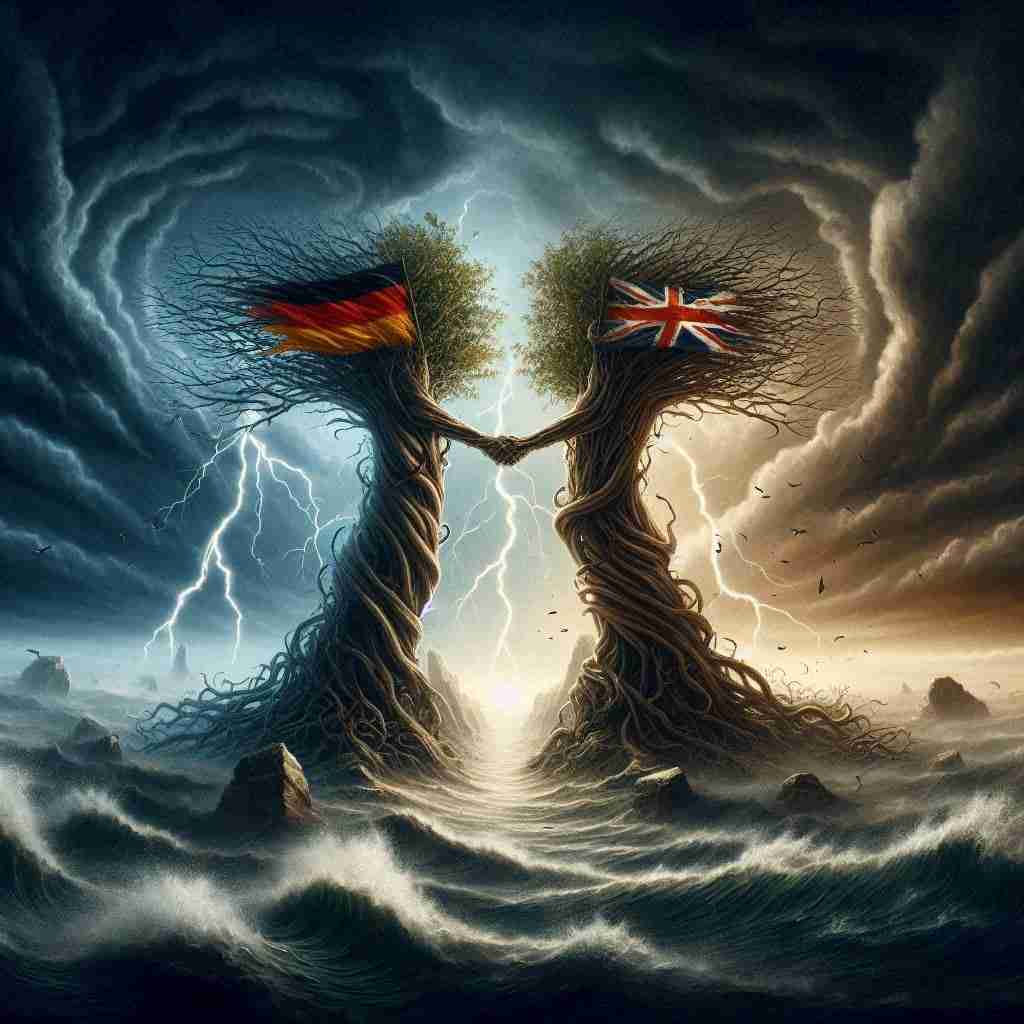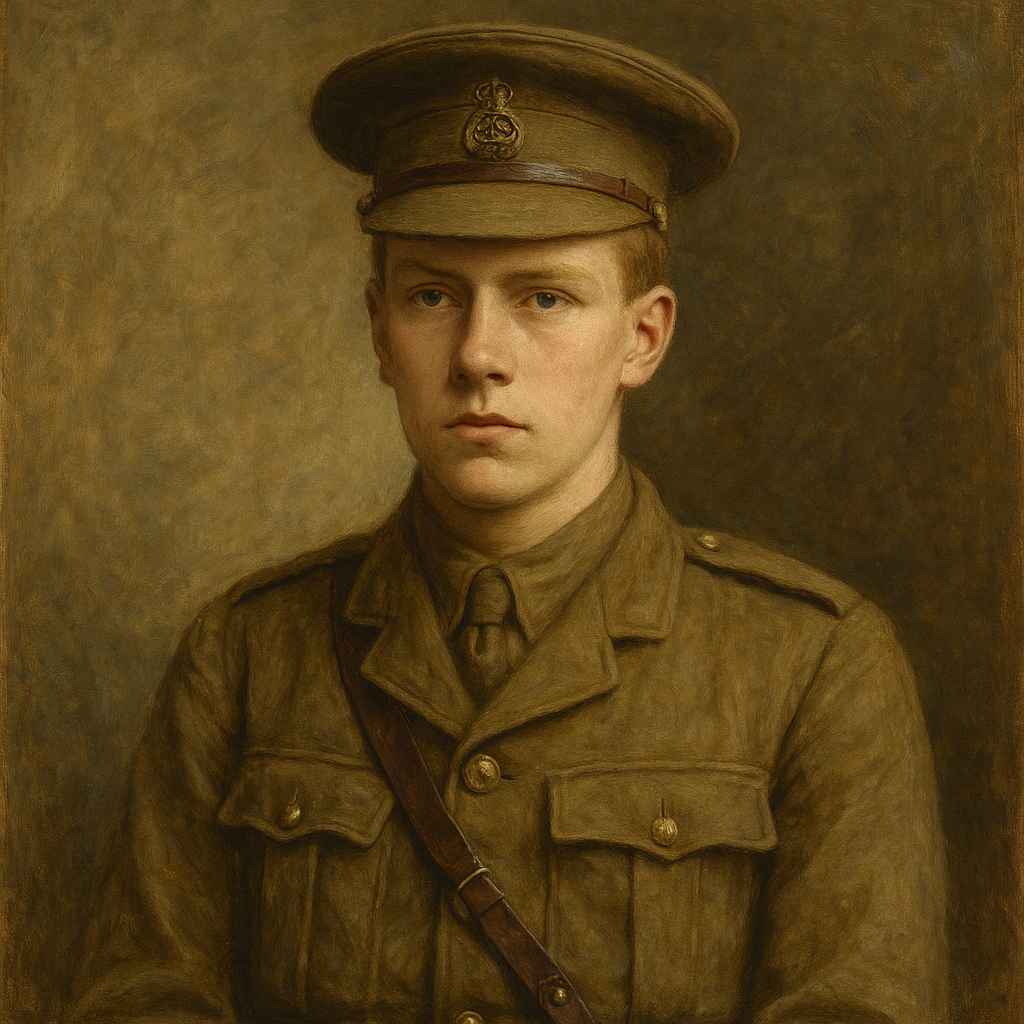To Germany
Charles Sorley
1895 to 1915

You are blind like us. Your hurt no man designed,
And no man claimed the conquest of your land.
But gropers both through fields of thought confined
We stumble and we do not understand.
You only saw your future bigly planned,
And we, the tapering paths of our own mind,
And in each other's dearest ways we stand,
And hiss and hate. And the blind fight the blind.
When it is peace, then we may view again
With new-won eyes each other's truer form
And wonder. Grown more loving-kind and warm
We'll grasp firm hands and laugh at the old pain,
When it is peace. But until peace, the storm
The darkness and the thunder and the rain.
Charles Sorley's To Germany
Introduction
Charles Hamilton Sorley's sonnet "To Germany," penned during the tumultuous period of World War I, stands as a poignant reflection on the nature of conflict and the human condition. This poem, remarkable for its empathetic stance towards the enemy and its nuanced understanding of war's futility, offers a complex meditation on blindness—both literal and metaphorical. Through a careful analysis of Sorley's linguistic choices, structural elements, and thematic depth, we can uncover layers of meaning that speak not only to the historical context of the Great War but also to universal truths about human nature and the devastating consequences of ideological division.
Historical Context and Biographical Influence
To fully appreciate the depth of "To Germany," one must first consider Sorley's unique perspective. As a young British poet who had spent time in Germany before the war, Sorley possessed a rare empathy for the 'enemy' that many of his contemporaries lacked. This biographical detail infuses the poem with a poignant authenticity, as Sorley grapples with the cognitive dissonance of fighting against a nation he once admired.
The poem's composition in 1914, at the outset of World War I, places it within a crucial historical moment. Unlike the initial wave of patriotic verse that swept through Europe, Sorley's work stands out for its sober reflection and reluctance to demonize the opponent. This contextual understanding allows us to appreciate the poem not just as a literary work, but as a historical artifact that captures the complex emotions of a generation thrust into unprecedented global conflict.
Structural Analysis
"To Germany" adheres to the sonnet form, specifically the Petrarchan or Italian sonnet structure, with its octave (first eight lines) and sestet (final six lines) division. This choice of form is significant, as the sonnet traditionally deals with love and internal conflict. By applying this structure to the theme of war, Sorley subverts expectations and suggests that the relationship between warring nations is as complex and fraught as any love affair.
The octave presents the problem: the mutual blindness and misunderstanding between nations. The volta, or turn, occurs at the ninth line with "When it is peace," shifting the focus to a hypothetical future of reconciliation. This structural division mirrors the thematic content, emphasizing the stark contrast between the present state of conflict and the potential for future understanding.
Linguistic and Rhetorical Devices
Sorley's mastery of language is evident throughout the poem. The repetition of "blind" and its variants ("blindness," "blind fight the blind") serves as a central motif, emphasizing the theme of ignorance and misunderstanding. This blindness is not just physical but intellectual and emotional, as evidenced by phrases like "fields of thought confined" and "tapering paths of our own mind."
The use of second-person address ("You are blind like us") creates an immediate sense of dialogue with the enemy, humanizing them and establishing a common ground of shared experience. This rhetorical strategy is particularly effective in breaking down the us-versus-them mentality typical of wartime propaganda.
Alliteration and assonance contribute to the poem's musicality and reinforce its themes. The harsh consonants in "hiss and hate" evoke the bitterness of conflict, while the softer sounds in "Grown more loving-kind and warm" suggest the gentler emotions of peace and reconciliation.
Thematic Exploration
At its core, "To Germany" is an exploration of the concept of blindness as a metaphor for the limitations of human understanding. Sorley suggests that both sides in the conflict are equally blind, stumbling through "fields of thought confined." This mutual blindness leads to misunderstanding and conflict, as neither side can truly see or comprehend the other's perspective.
The poem also grapples with the theme of national identity and the dangers of unchecked patriotism. The line "You only saw your future bigly planned" critiques the grandiose national ambitions that led to war, while also acknowledging that both sides are guilty of such myopic thinking.
Perhaps most strikingly, Sorley introduces the possibility of reconciliation and mutual understanding in the sestet. The repeated phrase "When it is peace" acts as a hopeful refrain, imagining a future where former enemies can "view again / With new-won eyes each other's truer form." This vision of post-war reconciliation is remarkably prescient, anticipating the efforts at European integration that would follow World War II.
Imagery and Symbolism
The poem is rich in vivid imagery that reinforces its themes. The metaphor of "gropers" stumbling through confined fields of thought evokes a sense of disorientation and limitation. This image is contrasted with the "bigly planned" future, suggesting the disconnect between grandiose national ambitions and the reality of human limitations.
The sestet introduces natural imagery associated with both war and peace. The "storm / The darkness and the thunder and the rain" symbolize the chaos and destruction of war, while the imagined peace is associated with warmth and clarity of vision. This juxtaposition underscores the poem's central contrast between the blindness of conflict and the potential for understanding in peacetime.
Comparative Analysis
"To Germany" can be fruitfully compared with other World War I poetry, particularly the works of Wilfred Owen and Siegfried Sassoon. While these poets are often remembered for their graphic depictions of trench warfare, Sorley's approach is more philosophical, focusing on the psychological and moral dimensions of conflict.
In its empathetic stance towards the enemy, Sorley's poem also anticipates later works like Randall Jarrell's "The Death of the Ball Turret Gunner" from World War II, which similarly humanize the experience of the 'other side' in warfare.
Critical Reception and Legacy
Initially overlooked in favor of more overtly patriotic or graphic war poetry, "To Germany" has gained increasing recognition in recent decades for its nuanced treatment of conflict and its prescient call for mutual understanding. Critics have praised Sorley's ability to transcend nationalist rhetoric and offer a more universal meditation on the human cost of war.
The poem's legacy is particularly poignant given Sorley's own fate—he was killed in action in 1915 at the age of 20. "To Germany" thus stands not only as a powerful anti-war statement but as a testament to the potential cut short by the very conflict it critiques.
Conclusion
Charles Sorley's "To Germany" emerges as a work of remarkable maturity and insight, especially considering the youth of its author and the charged atmosphere in which it was composed. Through its skillful use of the sonnet form, evocative imagery, and complex thematic exploration, the poem offers a timeless reflection on the nature of conflict and the possibilities for human understanding.
The poem's central metaphor of blindness serves as a powerful indictment of the narrow nationalisms that led to World War I, while also suggesting the potential for a more enlightened future. In an era where global conflicts continue to arise from misunderstanding and ideological rigidity, Sorley's vision of mutual recognition and reconciliation remains as relevant as ever.
Ultimately, "To Germany" stands as a testament to the power of poetry to transcend national boundaries and speak to universal human experiences. It challenges us to consider the limitations of our own perspectives and to strive for the kind of empathetic understanding that Sorley envisioned—a vision all the more poignant for having been articulated in the midst of one of history's most destructive conflicts.
This text was generated by AI and is for reference only. Learn more
Want to join the discussion? Reopen or create a unique username to comment. No personal details required!



Comments
No comments yet. Be the first to comment!